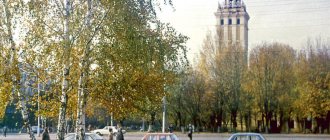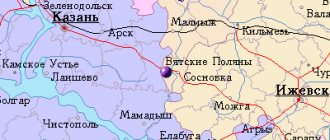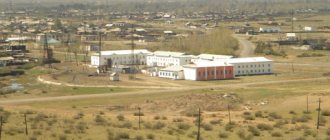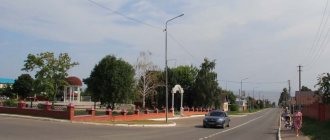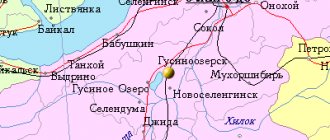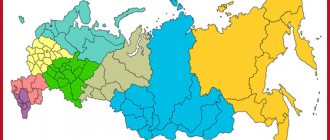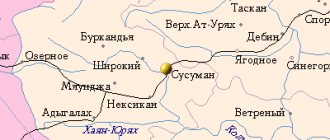Malmyzh
(Kirov region)
OKATO code:
33223501
Founded:
15th century.
City since:
15th century
City of district subordination (Malmyzh district, Kirov region) Center:
Malmyzh district
Telephone code (reference phone)
| 83347***** | 22-2-22 |
Deviation from Moscow time, hours:
0
Geographic latitude:
56°31′
Geographic longitude:
50°40′
Altitude above sea level, meters:
100 Sunrise and sunset times in the city of Malmyzh
History[edit]
| In this section do not cite any sources . |
It was first mentioned as the Mari village of Malmyzh in the 15th century. Malmyzh was the capital of the Mari Malmyzh principality, subordinate to Kazan. The Mari prince Boltush (Poltish) resisted the Russian advance and was killed by a cannonball on April 26, 1556. In 1584, a Russian fortress was built here to suppress the rebellious Mari people. Received city status in 1780.
Map
| Malmyzh: maps |
Malmyzh: photo from space (Google Maps) Malmyzh: photo from space (Microsoft Virtual Earth)
| Malmyzh. Nearest cities. Distances in km. on the map (in brackets along roads) + direction. Using the hyperlink in the distance , you can get the route (information courtesy of the AutoTransInfo website) | |||
| 1 | Baltasi (Republic of Tatarstan) | 33 (77) | SW |
| 2 | Kukmor | 39 (70) | YU |
| 3 | Shemordan (Republic of Tatarstan) | 40 (57) | SW |
| 4 | Vyatskiye Polyany | 41 (57) | SE |
| 5 | Krasnaya Polyana | 41 (64) | SE |
| 6 | Sosnovka | 48 (72) | SE |
| 7 | Kilmez | 53 (57) | NE |
| 8 | Bogatye Saby (Republic of Tatarstan) | 57 (78) | YU |
| 9 | Kizner (Udmurt Republic) | 58 (323) | SE |
| 10 | Arsk | 68 (69) | SW |
| 11 | Mari-Turek (Republic of Mari El) | 70 (312) | NW |
| 12 | Tyulyachi (Republic of Tatarstan) | 74 (93) | YU |
| 13 | Urzhum | 78 (87) | NW |
| 14 | Bolshaya Atnya (Republic of Tatarstan) | 80 (105) | Z |
| 15 | Paranga (Republic of Mari El) | 80 (309) | Z |
| 16 | Vavozh (Udmurt Republic) | 81 (199) | IN |
| 17 | Syumsi (Udmurt Republic) | 87 (98) | NE |
| 18 | Mozhga | 95 (287) | IN |
| 19 | Grakhovo (Udmurt Republic) | 95 (289) | SE |
| 20 | Mamadysh | 101 (130) | SE |
| 21 | Morki (Republic of Mari El) | 103 (275) | Z |
| 22 | Sernur (Republic of Mari El) | 103 (275) | NW |
| 23 | Pestretsy (Republic of Tatarstan) | 105 (138) | SW |
| 24 | railway station High Mountain (Republic of Tatarstan) | 106 () | SW |
| 25 | Uva (Udmurt Republic) | 106 (167) | NE |
| 26 | High Mountain (Republic of Tatarstan) | 107 (110) | SW |
| 27 | No | 110 (146) | WITH |
| 28 | Kuzhener (Republic of Mari El) | 112 (282) | Z |
| 29 | Alnashi (Udmurt Republic) | 117 (249) | IN |
| 30 | Elabuga | 118 (189) | SE |
a brief description of
It is located in an area crossed by ravines, at the confluence of the Zasora, Moksha and Krupny Lach rivers into the river. Shoshma (tributary of the Vyatka), 57 km northwest of the railway. Vyatskie Polyany station, 294 km southeast of Kirov.
Territory (sq. km): 7
Information about the city of Malmyzh on the Russian Wikipedia site
Historical sketch
It was first mentioned as the Mari village of Malmyzh (“resting place, overnight stay”) in the 15th century. From the beginning of the 16th century. belonged to the Mari prince-leader Boltush. In 1553, after the capture of Kazan, it was transferred to particularly distinguished archers of the Vyatka regiment.
In 1584, to protect Malmyzh from the attacks of the Tatars and Bashkirs, a fortress was built, which gave the settlement the status of a city.
In 1708, a suburb of Kazan, Malmyzh was assigned to the Kazan province, since 1719 in the Kazan province. Since 1780, the district town of the Vyatka governorate (since 1796 - the Vyatka province).
In the middle of the 19th century. Malmyzh is a shopping center. There were 9 stone buildings in the city. In 1856, in the district town of Malmyzh, Vyatka province, there were 2 churches, 211 houses, 36 shops.
At the beginning of the 20th century. known as a place of political exile.
In 1931, a repair and maintenance workshop for the river motor fleet was built.
In the 1950s Processing of agricultural products developed (production of canned vegetables, fruits and meat), woodworking enterprises, brick factories and beer factories were built.
Economy
Factories: mechanical repair, canning, brewing, reinforced concrete products. Industrial plant.
In the Malmyzh region, barley, peas, rye, and potatoes are grown. Cattle are raised.
Deposits of clay, limestone, crushed stone, peat.
Culture, science, education
Museum of Local Lore.
Museums, galleries, exhibition halls
Malmyzh Museum of Local Lore 612920, Kirov region, Malmyzh district, Malmyzh, st. Chernyshevsky, 1
Architecture, sights
The city's buildings are predominantly wooden, with two-story buildings of former merchant mansions from the 19th and early 20th centuries standing out. Epiphany Cathedral (1802).
In the 1960-80s. 3-story houses are built on the outskirts of the city.
| Population by year (thousands of inhabitants) | |||||||
| 1856 | 1.8 | 1979 | 11.5 | 2005 | 9.1 | 2014 | 7.6 |
| 1897 | 3.2 | 1989 | 10.7 | 2006 | 9.0 | 2015 | 7.5 |
| 1913 | 3.7 | 1992 | 10.5 | 2007 | 9.0 | 2016 | 7.6 |
| 1926 | 4.4 | 1996 | 10.4 | 2008 | 8.9 | 2017 | 7.5 |
| 1931 | 4.5 | 1998 | 10.2 | 2010 | 8.8 | 2018 | 7.4 |
| 1939 | 6.5 | 2000 | 10.1 | 2011 | 8.3 | 2019 | 7.3 |
| 1959 | 9.1 | 2001 | 10.0 | 2012 | 8.1 | 2020 | 7.2 |
| 1970 | 11.2 | 2003 | 9.3 | 2013 | 7.9 | 2021 | 7.0 |
Malmyzh and Malmyzh people in old photographs.
- Vyatka stories
- Retro photo
I decided to exhibit a number of photographs related to the Malmyzh region, all scanned from the originals, some kindly provided by the Malmyzh Museum. I only post photos that I think will be interesting. This photo shows a view of Malmyzh from Boltushina Mountain, 1926, photo by D.A. Loginov. The author photographed part of the city, there are very few stone buildings, and there is a spring flood on the Vyatka River.
The following photo shows the production workshop of the Aleksanrova distillery in the village
Kalinino, Malmyzh district, on the back it says laboratory, but I think that this is not so, the diameters of the pipes and columns are clearly not laboratory. Several similar photos were taken using the “Virpsha” photograph, unfortunately the quality is not very good, most likely it is from the 19th century, there may not have been local photographers yet and therefore they invited the “Sarapulians”. Many of my relatives living in Kalinino worked at this plant, including my great-grandfather Alexander Aleksandrovich Sushintsev (1861-1946) and before my marriage my grandmother Chernova (Sushintseva) Anna Alexandrovna (1886-1968). In Soviet times, my distant relative Anna Georgievna Sorokina (Sushintseva) worked at the plant from 1944 to 1985 (she and I meet somewhere after the 5th generation). Anna Georgievna, Aunt Nyura, as she asks to be called, was born in 1923 and now, at 97 years old, she tells a lot of interesting things. The plant was supplied with water from a source by gravity, the water was softened, the pipes ran along the street where the Sushintsevs lived; in Soviet times, wooden ones were replaced with steel ones. When Aunt Nyura went to a meeting of representatives of distilleries in the city of Vladimir, everyone was surprised by the water supply system of the plant. A tasting was held at the meeting and the distillery’s alcohol was recognized as being of good quality. I heard the following story from my great-grandfather: sometimes at the factory workers were given unrefined alcohol and my great-grandfather, coming home in the evening, poured it into a glass, poured salt for purification, drank it and often afterwards scolded his wife for giving birth to five daughters in 1902. .son Peter was born. The next photo also depicts the production of alcohol-containing liquid, only the technologies are slightly different, but as you can see, the distillation process is in full swing. The presence of a steam chamber in the middle part of the apparatus indicates that there is a struggle for quality, and the ring on the finger of the “bottling operator” indicates the profitability of production. And what did the “Vyatka” people do from wood? Inscription on the back: Malmyzh district.
In this photo, the family of Sushintsev’s grandmother’s brother Pyotr Aleksandrovich (1902-1974), photo somewhere in 1930, in 1933 the OGPU was convicted under Article 58 to 10 years in concentration camps, rehabilitated in 1956. The boy in the photo, son Vladimir, in During the war he was captured by the Germans, while his father was still serving time.
In these two photographs by photographer D.A. Loginov’s view of the crossing built across Vyatka by the Reds after the failed last offensive of the Kolchakites near the village of Gonba in the spring of 1919. During the shelling of Gonba by the Whites, one of the shells hit the house where Aunt Nyura’s mother, Anisya Andreevna Kryazheva, lived with her parents, the house burned down.
In this photo, my grandfather Alexander Maksimovich Chernov, S.St. Burets, 30s.
In this photo, my great-grandfather Maxim Fedorovich Chernov, great-grandmother Nadezhda Demidovna and their grandson Lenya, photo 1908 Malmyzh.
This photograph is most likely from 1923, and in it the participants of the agricultural exhibition in Malmyzh, of his own, found only I.I. Stokis, in the top row, second from the right, but did not determine what kind of building it was.
In this photo, graduates of the Malmyzh secondary school, 1942. Mikhail Rukavishnikov and my father Vasily Aleksandrovich Chernov graduated from the Kazan Medical Institute in 1952, later Rukavishnikov was a military medic. In total, in 1942 there were two tenth grades, and Aunt Nyura studied in the parallel one. In her words: Aleksey Nikanorovich Gulyaev was the head teacher at the school, Klavdiya Aleksandrovna Ivanova, a history teacher of grades 9-10, was very strict.
The next four photographs are different views of Malmyzh and the Shoshma River, most likely from the 50s-60s.
Links[edit]
Notes[edit]
- ^ abcdefgh Law No. 203-ZO.
- ^ a b Federal State Statistics Service (2011). “All-Russian Population Census 2010. Volume 1" [All-Russian Population Census 2010, vol. 1]. All-Russian Population Census 2010 [All-Russian Population Census 2010]
. Federal State Statistics Service. - "26. The size of the permanent population of the Russian Federation by municipalities as of January 1, 2022". Federal State Statistics Service. Retrieved January 23, 2022.
- ^ abcde Law No. 284-ZO
- "On the Calculation of Time". Official Internet portal of legal information
. June 3, 2011. Retrieved January 19, 2022. - Post office. Information and computing center of OASU RPO. ( Post office
).
Search for postal service objects ( postal Search for objects
) (in Russian) - ↑
Federal State Statistics Service of Russia (May 21, 2004).
“The population of Russia, the constituent entities of the Russian Federation as part of federal districts, urban settlements, settlements, settlements of 3 thousand or more people” [Population of Russia, its federal districts, federal districts, districts, urban settlements, rural settlements - administrative centers and rural settlements with a population of more than 3,000 people] (XLS). All-Russian Population Census 2002
. - “All-Union Population Census of 1989. The current population of union and autonomous republics, autonomous regions and districts, territories, effects, urban settlements and rural district centers” [All-Union Population Census of 1989: current population of union and autonomous republics, Autonomous regions and districts, territories, regions, districts, urban settlements and villages performing the functions of district administrative centers. All-Union Population Census of 1989 [All-Union Population Census of 1989]
.
Institute of Demography of the National Research University: Higher School of Economics [Institute of Demography of the National Research University: Higher School of Economics]. 1989 - via Demoscope Weekly
.
